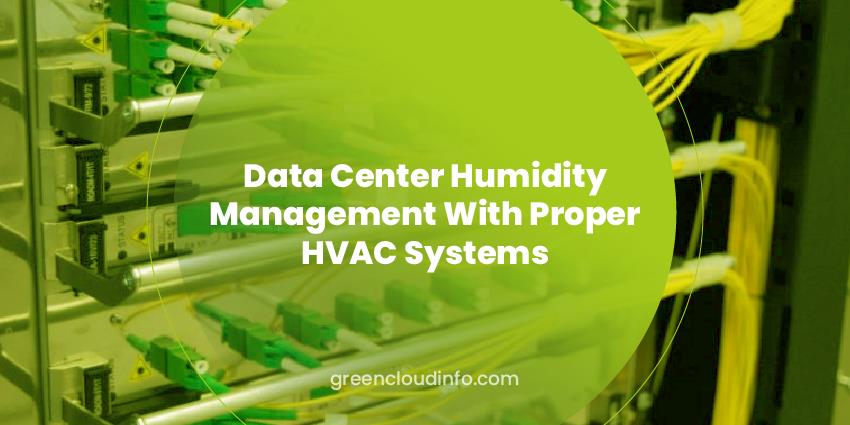Regarding data center humidity management, having the right HVAC system is critical. Without the right conditions, you could invite disaster into your data center. Let’s look at why proper humidity management is so important and the best ways to ensure the moisture level in your data center is what it needs to be.
This article will discuss the importance of maintaining data center humidity and how best to do it.
Why is Managing Data Center Humidity Important?
When the server room is maintained at an optimal temperature, there are no air leaks into or out of the room, and the HVAC system is designed to prevent contaminants from entering the data center from the outside, the risk of damage from electrostatic discharge (ESD), corrosion, electrical noise interference and overheating are significantly reduced. In arid environments, condensation can form on surfaces within the data center, resulting in a risk of short-circuiting equipment or causing other damage.
Humidity control in a data center is essential for some reasons. One of the most significant considerations for IT staff and facility managers is the risk of moisture damage to equipment.
- If the room where the servers are housed is too hot or too cold, the hard drives that store the data could stop spinning correctly.
- With too little humidity in a server room, computers can develop problems with static electricity and damaged circuit boards.
Too little humidity could also cause materials in the room, like concrete floors or metal tools, to corrode faster than usual. If there’s too much humidity in a server room, water condenses on equipment and forms pools on the floor.
After understanding the importance of humidity control in the data center, let’s know the best way to manage data center humidity.
Data Center Humidity The Best Practices
The ideal relative humidity for a data center is between 40% and 60%, with a dew point of 68°F or lower. This will keep all components safe from condensation buildup and will help ensure that your ventilation system can remove excess heat, which means you’ll be able to run it at a cooler temperature. The humidity level in a data center should be balanced with the number of people occupying it; if there are fewer people in a large room, the air should be drier to prevent excess moisture buildup that can cause static shocks or corrosion.
Following are some best practices for ensuring that your data center’s HVAC system is working correctly:
- Install dehumidifiers in all areas where air conditioning is used.
- Use proper ventilation and air filtration systems when using humidifiers.
- Monitor humidity levels throughout the facility.
The air inside a data center has a much higher concentration of dry air than the air outside. Data centers use a combination of air conditioning and heating to control the temperature and humidity of the air inside.
Improper humidity levels could cause adverse effects on the hardware in the servers and routers, leading to issues like overheating and malfunctioning equipment. This is why data centers need to have proper HVAC systems that can maintain optimal humidity levels.
Your HVAC system can control humidity
To understand how humidity can affect data center operations, we must first understand how HVAC systems work. The temperature is generally measured by the amount of heat energy it holds. Humidity, however, refers to the amount of water vapor in a given space. HVAC systems keep humidity in check by supplying air at varying temperatures and rates depending on the season and weather conditions.
Cooling costs are also a factor here: If a cooling system is not used correctly, it could cause excess condensation in humid climates, leading to more frequent shutdowns. To control temperatures and keep costs down, many data centers use temperature-humidity sensors (THS) that can monitor both factors independently and adjust HVAC systems accordingly.
Read also: Data Center Environmental Impacts on Climate Change
Steps to maintaining proper humidity in a data center
Humidity management in a data center is a complex task. Various steps can be taken to keep the humidity at optimal levels for the data center’s equipment, staff, and physical environment.
The first step is to have a plan for maintaining proper humidity levels. The plan should include monitoring, measuring, and recording the humidity levels.
It is essential to understand that there are three main types of humidity measuring devices: – Hygrometer – measures relative humidity, usually displayed as a percentage – Psychrometer – measures combined temperature and relative humidity, usually displayed as a dew point value – Wet-bulb thermometer – measures only temperature and relative humidity, no dew point, used for cooling calculations.
It is also essential to know what conditions will cause the air to be too humid or too dry for the data center. Several variables affect this, including temperatures in the data center, outdoor conditions, climate controls, local geography, HVAC system design, and location of servers.
Once all of these factors are taken into consideration, it is essential to understand how they influence each other and will determine if there any changes need to be made. This will help you be proactive in managing humidity within your data center.
Conclusion
Data centers, especially colocation and hosting facilities, are all about efficiency, and humidity is no exception. The right humidity management system can help improve data center uptime, reduce energy costs and increase the effectiveness of cooling systems.
We must take action to preserve our planet’s resources; otherwise, we’ll run out of them before we run out of demand for them. With that in mind, sustainable data center design is becoming increasingly important. One way sustainability can be achieved by ensuring that data centers operate at peak efficiency.
To do so, they must have an optimal environment for server installation and maintenance—one that’s not too hot or too cold, one with a constant humidity level and a stable temperature.
Humidity is an integral part of keeping your data center running smoothly. A data center’s humidity levels should be monitored regularly and controlled with an HVAC system.
Many data centers will include humidity management in their HVAC systems, but they sometimes need to do it right. It’s easy to understand why: determining how much humidity you want and how to manage it is a complicated thing. Luckily, there are plenty of resources online to learn about humidity management in your data center so that you can do it right!

